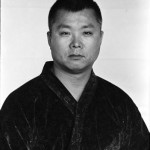
To honor the late Grandmaster Min Pai (1935 – 2004) and carry on the Ultimate style that he created Yang Pai Tai Chi Chuan.
We teach the modified Yang Style 108 Long Form of Tai Chi Chuan. Grandmaster Pai learned this form directly from one of Yang Cheng Fu’s top students, Cheng Man-ch’ing. In 1928 Cheng Man-ch’ing met the well-known master Yang Chengfu, with whom he began to study Yang style t’ai chi ch’uan, which he did until 1935. Grandmaster Pai modified the original 108 movement form, creating a more balanced and effective fighting form which we call Yang Pai Tai Chi. This form along with Zen meditation will help you develop incredible power, bone density and help you become grounded.
“Tai Chi Saying When a man is born, he is soft and weak. When a man dies, he becomes stiff and hard. Thus the stiff and unyielding follow death, the soft and yielding follow life.”

Cheng Man-ch’ing was born in 1902 and passed away in 1975 during a visit to Taiwan. He was born in Yongjia, what is now present-day Wenzhou, Zhejiang Province in China. Many regard Cheng Man-Ching (Often referred to as Professor) as the man who brought Tai Chi to the west. Cheng Man-Ching moved to the United States in 1964, where he taught at the New York T’ai Chi Association and then the Shr Jung T’ai Chi school in New York City’s Chinatown section with the assistance of his American senior students. Cheng Man-ch’ing is best known for his “Simplified” 37 Posture Yang Style T’ai Chi Chuan. *Simplified* does not mean easier. It was simplified in it’s length and complexity but not the quality or difficulty of the postures.

Yang Cheng-Fu was the grandson to Yang Lu-Chan the founder of the Yang-style Tai Chi Chuan. It was Cheng-Fu who finalized this style into the present-day form that is so popular all over the world. Learning Tai Chi Chuan from his father since early childhood, Yang Cheng-Fu showed great talent and learned very quickly, especially the “middle frame” of Yang style passed on by his grandfather to his father and uncle Yang Ban-Hou, both of whom had taught martial arts in the Prince of Duan’s mansion and enjoyed a great reputation in Beijing. As an adult, Yang Cheng-Fu was invited by the Beijing Sports Society to teach martial arts in the city and afterward he traveled to Wuhan, Nanjing, Guangzhou, Shanghai and Hangzhou to teach the Yang-style Tai Chi Chuan. Because of his modesty, gentleness and eagerness for perfection – which he seemed to have inherited from his grandfather, Yang Cheng-Fu was loved by all his disciples, who were scattered all over the country.

Master Yang Lu Chan is a master who has had the most impact and influence on the development of tai-chi chuan. He is often qualified as the first “stranger” to have been able to learn and master the secret art of tai-chi chuan under a member of the Chen family; the family which were the only ones to possess this knowledge until then. Thus the heritage of Yang Lu Chan continues to resound loud and strong today. Yang Lu Chan (also called Yang Fu Kui) was born in 1799 in the Hebeiprovince of China. According to many accounts, Yang began his tai-chi chuan apprenticeship in the Chen Jia Gou village in 1820 under Master Chen Ghang Hsing, with whom he trained until he was 18 years old. Because of his exceptional skills, he received permission from Master Hsing to teach tai-chi chuan and to have his own students. Yang Lu Chan went on to be nicknamed “Yang the Invincible” as he never lost one fight.
